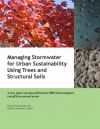Rooftops to Rivers: Green Infrastructure Strategies for Controlling Stormwater and Combined Sewer Overflows

This is a policy guide for decision makers looking to implement green strategies and includes nine case studies of cities that have successfully used green techniques to create a healthier urban environment. Included in the guide are nine helpful case studies of cities that have successfully used green techniques to create healthier urban environments.
Vision for North Vancouver's Maplewood Learning Centre: Create a watershed learning legacy

Richard Boase (120p)
The major work has been done, the salmon have returned to spawn as soon as the new habitat was finished. All we have to do now is finish it off.
Decentralized Stormwater Source Controls for Urban Retrofit and Combined Sewer Overflow Reduction

“Capturing rainwater where if falls offers appealing technical alternatives to stormwater runoff capture than conventional end-of-pipe measures. Decentralized controls have the potential to reduce the frequency and volume of CSO events. In addition, a decentralized approach to stormwater management allows communities the flexibility to respond to everchanging economic and environmental conditions,” stated Neil Weinsten.
RE-DEVELOPMENT CREATES A RESTORATION OPPORTUNITY FOR THE CAPITAL REGION’S BOWKER CREEK: “Like any long-term relationship, effort and commitment are required. Fortunately for Bowker Creek, many individuals and groups have decided to believe in a future where the water is clean, wildlife have a home, floods are controlled, and the creek is an asset to all the neighbourhoods it flows through,” stated Tanis Gower, Bowker Creek Initiative Coordinator

“Bowker Creek is like most urban creeks – it’s in rough shape. Luckily, it also has some advantages. Bowker Creek runs through a densely populated area full of citizens who want more nature, less pollution, and better greenway corridors in their neighbourhoods. They have supported their municipalities – Oak Bay, Saanich and Victoria – to become part of the Bowker Creek Initiative. With re-development comes opportunity for creek restoration or creek day-lighting (opening buried sections),” Tanis Gower wrote.
Town of Edmonston breaks ground on Maryland's first
The street retrofit project includes rain gardens and bioretention ponds that are expected to capture up to 90% of the rainwater runoff.
Four largest cities in Alberta and British Columbia are "Water Balance Model Partners"

The process of evolving current design practices for neighbourhoods, roadways, and the minor/major drainage system to manage the total volume – in addition to the peak rate of urban runoff – requires tools for planning and engineered site design.
Too much pavement, too little oversight: U.S. Environmental Protection Agency to tackle stormwater runoff
The EPA is now writing new regulations – expected to be enacted in 2012 – that will define what is expected of developers, possibly by setting limits for stormwater volume or concentrations of contaminants.
Aligning with New Directions: from Stormwater to RAINwater in Metro Vancouver

Ed von Euw (120p)
Metro Vancouver and Vancouver Island are learning from each other, and are moving in the same direction.
Managing Rainwater for Urban Sustainability Using Trees and Structural Soils

Stormwater Management: Using trees and structural soils – manual cover (360p)
Researchers know that urban forests, like rural forest land, can play a pivotal role in rainwater/stormwater mitigation. Structural soil reservoirs may provide new opportunities for meeting engineering, environmental, and greenspace management needs in urban areas.
University of the Fraser Valley: Jim Dumont introduced students to the science behind the Water Balance Model and demonstrated real-world applications for greening the urban environment and protecting stream health (Nov 2009)

“I have been teaching about the water cycle, water balance components and computations. So the students have a good understanding about hydrologic concepts, equations and computations. The best way to quarantee a balance between nature and urban development in the future is by teaching future planners and decision-maker today about cutting edge technology for designing with nature,” stated Dr. Ineke Kalwij. “Jim Dumont demonstrated how to integrate all of the technical things that my students have been shown in class. In his presentation, Jim’s emphasis was on the information and techniques that are important in providing solutions and value to society.”

